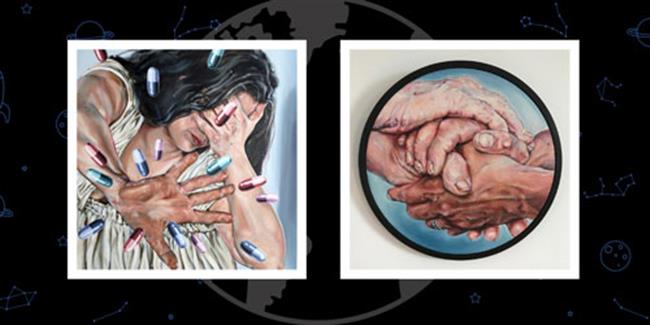The Global Search for Education: Addiction and How Art Can Help

This month, audiences can screen a Planet Classroom original, Addiction & Art: Spotlight on Dopamine on the Network’s YouTube Channel. The video by artist, author and teacher Margaret Dowell explores addiction through artworks.
In the video, viewers will meet Margaret Dowell who believes in using art as a form of communication in the frozen in time Sunderland schoolhouse.
Dowel’s collection of 4 oil canvases, which include two diptychs, explores the effects of added dopamine by drugs and alcohol. Just like every great lesson taught, it ends in a call of action and empowerment.
Artist Margaret Dowell (MFA in Art, PhD in Education) currently teaches for the Art Department at Carroll Community College. She is a co-author of Addiction and Art: Revealing the Face of Addiction and Recovery, which puts a human face on addiction through the creative work of people who have been touched by it.
The Global Search for Education is pleased to welcome Margaret Dowell.
Margaret, how does art therapy work? What do you believe are the main benefits of being creative in rehab?
It is no mistake that humans are naturally creative. Art is simply one expression of that innate creativity. It makes perfect sense that for some individuals, supportive therapy through art could be valuable in the healing process.
There are certainly therapeutic benefits of both the creating of art and the viewing of the art work of others. Art, the creating and viewing, can be utilized to help people explore emotions, cope with stress, boost self-esteem, moods, etc. But perhaps even more important, Art has the power to improve our well-being by helping us understand our own perspectives – perspectives that may be felt, analyzed and shifted towards reinforcing more positive behaviors – ultimately leading to healthier lifestyles. As broken lives are pieced back together, it’s wise for professionals and individuals alike to consider Art as yet another tool in the toolbox.
I understand the reason behind making “Sidi Started Drinking at 9,” a diptych. Can you tell me about your decision to link your two cats with the brain scan diptych?
The brain scans in this diptych reference the brain imaging work by Dr. Nora Volkov at the National Institute of Drug Abuse. Drug use changes brain chemistry. Specifically, it can destroy the dopamine neurons in the brain’s pleasure centers making it almost impossible for someone to experience any natural pleasures at all. The brain images depicted show the effect by the loss of a color, red. To drive this message home, I used familiar subject matter, my cats, Darlin’ and Angel. I spoke in the video of the difference in color between them (Angel has more white) and echoed the difference in color of the brain scans above the cats (the healthy brain has more red). As the concept of losing dopamine neurons may be too abstract for young people, I shortened the concept to the loss of red – something Angel said is not a good thing. I’m betting on the images of the cats with the brain scans to be more memorable than drug/brain verbiage.
The color red is used as a vital part of all this collection. Can you tell me why you chose red instead of another color?
Our response to color is not merely optical, but emotional. Red is simply a standout color. It has more associations, more symbolism than any other color. It can signify such diverse topics as love and hate, and patriotism and anarchy. It is hard to be indifferent to red. It’s seldom ignored.
Who do you believe is the primary audience for your video? What do you hope are the main takeaways?
I created the Addiction & Art video with young people in mind, although the information is certainly relevant to all. Knowledge of course is power, and in this video I use my artworks as talking points to illustrate the effects of substance abuse on the brain. Although the ultimate goal for viewers is prevention, I also stress the importance of support when one is in the troughs of addiction and ready for recovery.
Thank you Margaret!

C. M. Rubin and Margaret Dowell
This month audiences can screen a Planet Classroom original, Addiction & Art: Spotlight on Dopamine, on the Planet Classroom Network’s YouTube Channel.
















